Analyzing Reduced Drink Drive Limits & Conviction Rates in England
VerifiedAdded on 2023/06/18
|7
|1905
|341
Report
AI Summary
This report investigates the potential impacts of reducing drink drive limits in England, mirroring actions taken by other countries, and assesses the likely effects on conviction rates. It highlights the risks associated with drunk driving, particularly among young drivers, and advocates for lowering the blood alcohol content (BAC) limit to reduce accidents and fatalities. The report examines the effectiveness of various measures, including zero tolerance policies, graduated licensing schemes, and increased sobriety checkpoints, drawing comparisons with international approaches, such as those in Costa Rica and New Zealand. Furthermore, it emphasizes the severe consequences of drink driving convictions, including financial burdens, imprisonment, and long-term personal and professional repercussions. The conclusion supports the reduction of BAC limits to 0.05 in the UK, coupled with comprehensive enforcement strategies and public awareness campaigns, to promote safer driving behavior and reduce conviction rates.
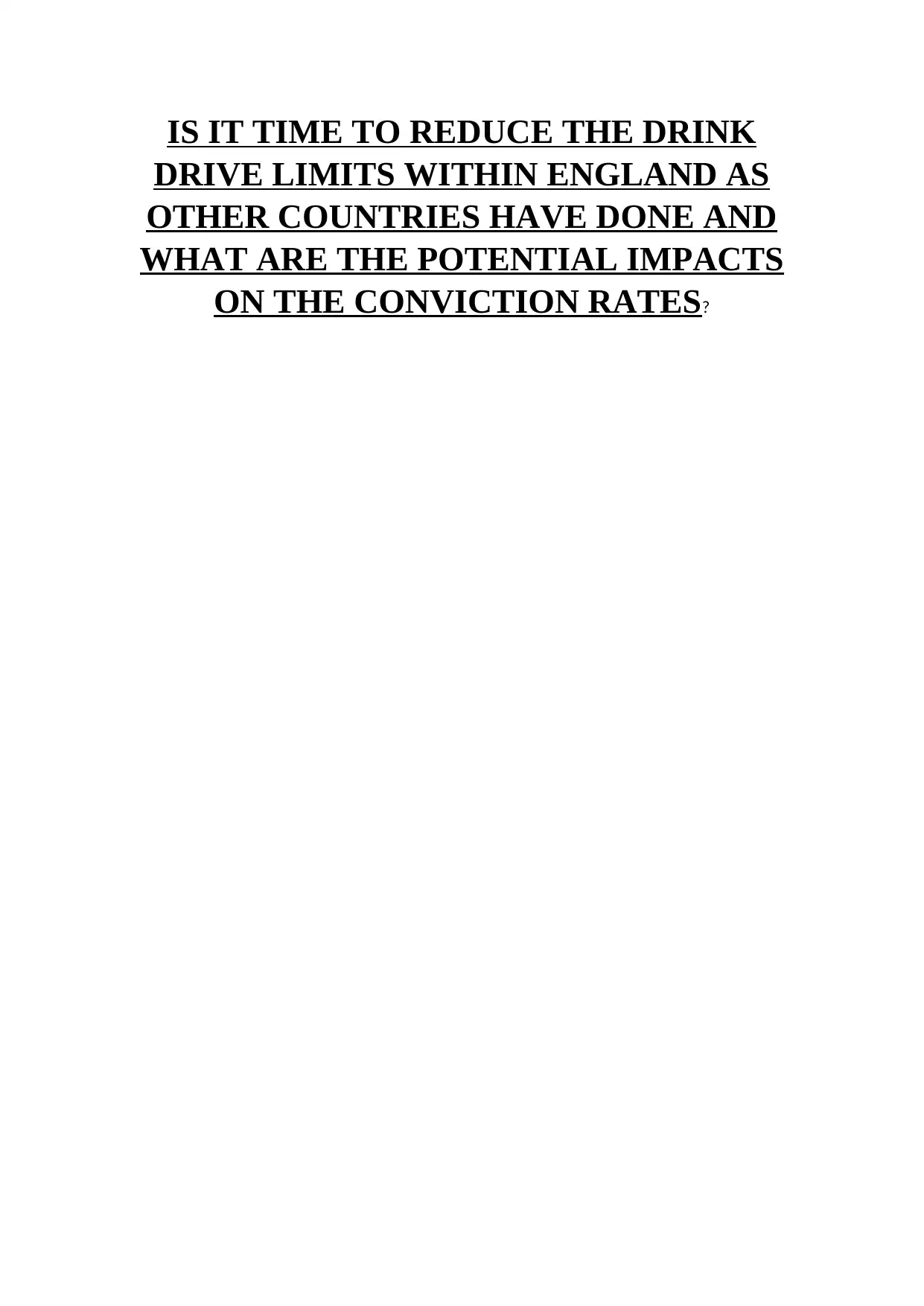
IS IT TIME TO REDUCE THE DRINK
DRIVE LIMITS WITHIN ENGLAND AS
OTHER COUNTRIES HAVE DONE AND
WHAT ARE THE POTENTIAL IMPACTS
ON THE CONVICTION RATES?
DRIVE LIMITS WITHIN ENGLAND AS
OTHER COUNTRIES HAVE DONE AND
WHAT ARE THE POTENTIAL IMPACTS
ON THE CONVICTION RATES?
Paraphrase This Document
Need a fresh take? Get an instant paraphrase of this document with our AI Paraphraser
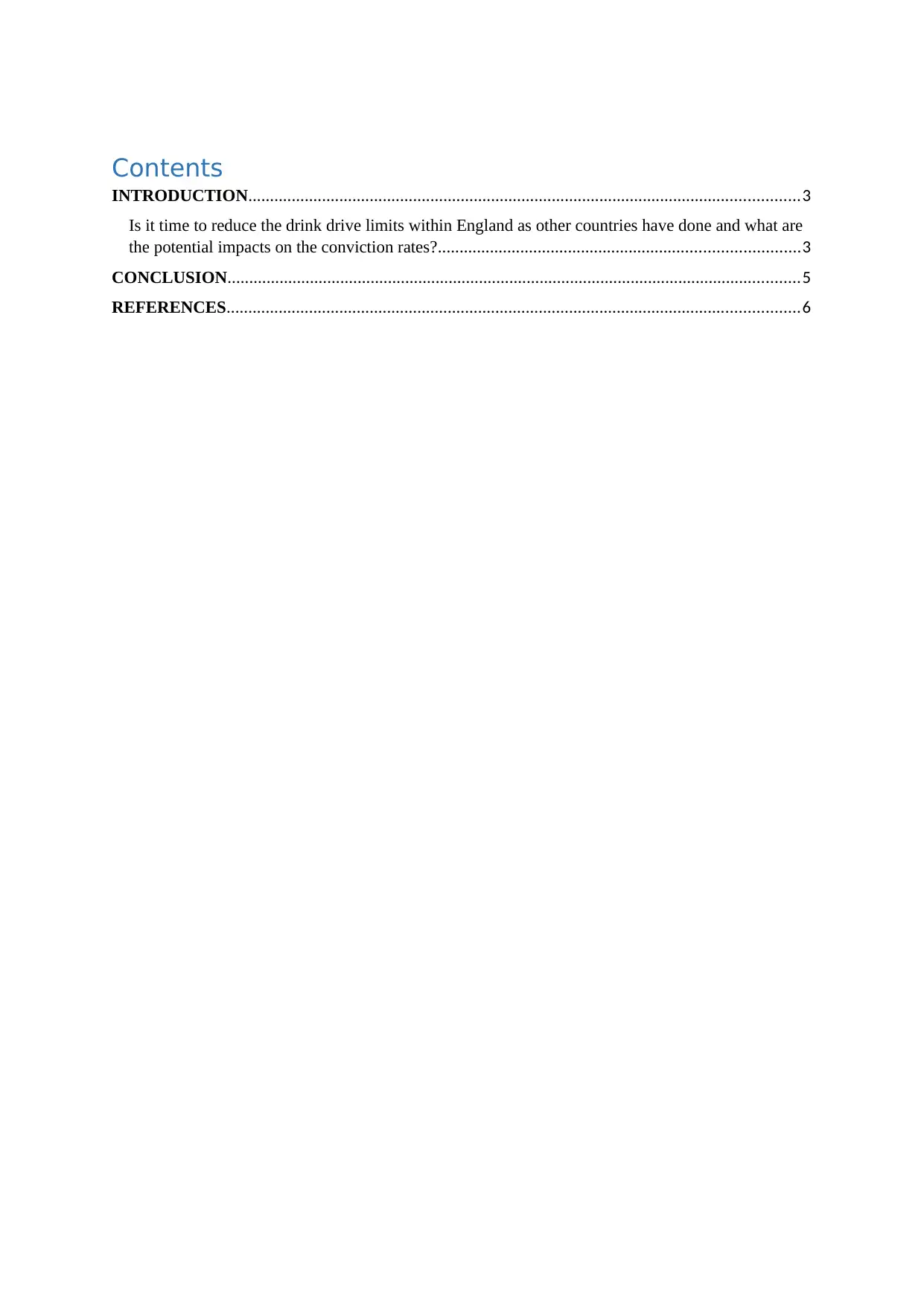
Contents
INTRODUCTION...............................................................................................................................3
Is it time to reduce the drink drive limits within England as other countries have done and what are
the potential impacts on the conviction rates?...................................................................................3
CONCLUSION....................................................................................................................................5
REFERENCES....................................................................................................................................6
INTRODUCTION...............................................................................................................................3
Is it time to reduce the drink drive limits within England as other countries have done and what are
the potential impacts on the conviction rates?...................................................................................3
CONCLUSION....................................................................................................................................5
REFERENCES....................................................................................................................................6
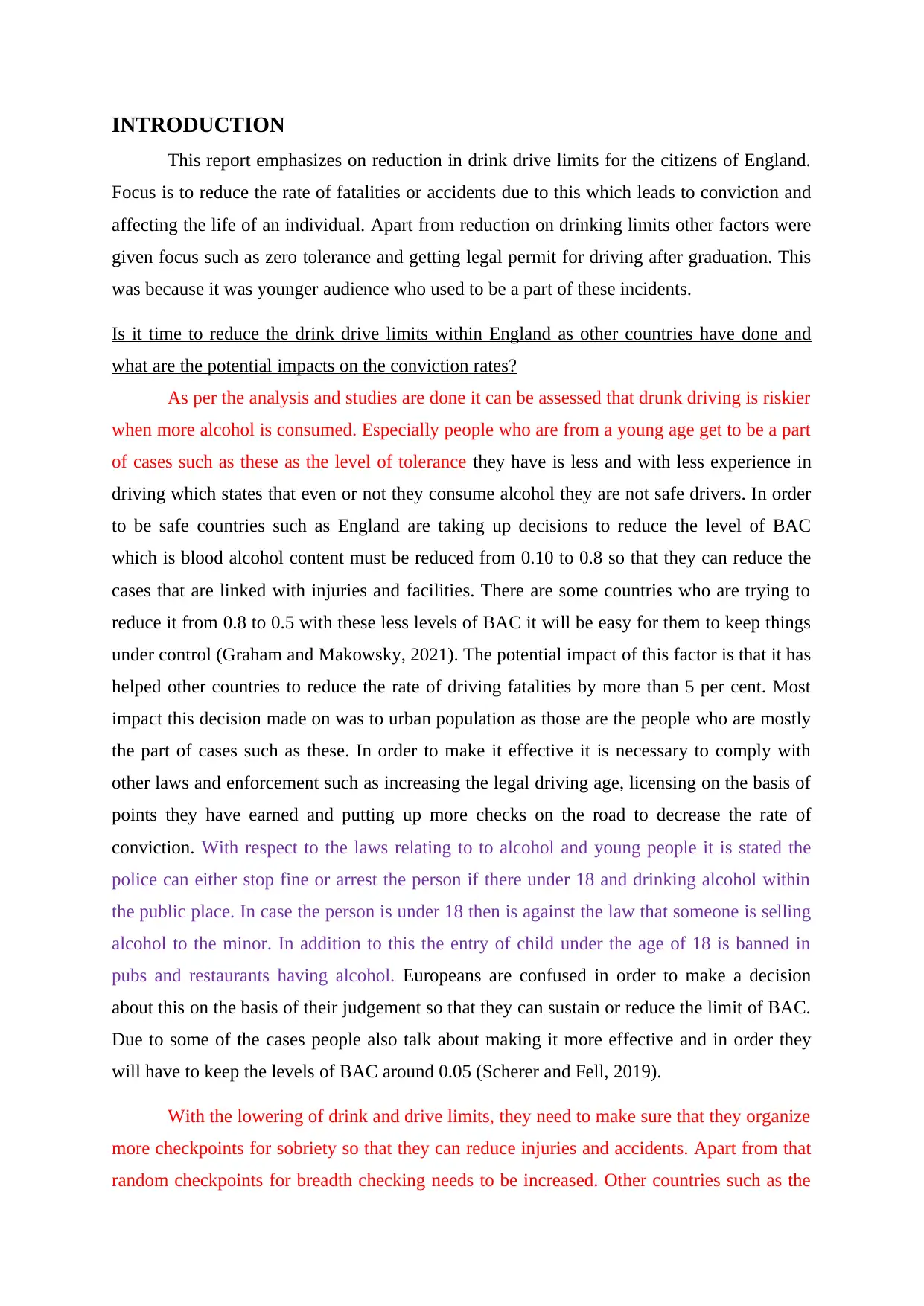
INTRODUCTION
This report emphasizes on reduction in drink drive limits for the citizens of England.
Focus is to reduce the rate of fatalities or accidents due to this which leads to conviction and
affecting the life of an individual. Apart from reduction on drinking limits other factors were
given focus such as zero tolerance and getting legal permit for driving after graduation. This
was because it was younger audience who used to be a part of these incidents.
Is it time to reduce the drink drive limits within England as other countries have done and
what are the potential impacts on the conviction rates?
As per the analysis and studies are done it can be assessed that drunk driving is riskier
when more alcohol is consumed. Especially people who are from a young age get to be a part
of cases such as these as the level of tolerance they have is less and with less experience in
driving which states that even or not they consume alcohol they are not safe drivers. In order
to be safe countries such as England are taking up decisions to reduce the level of BAC
which is blood alcohol content must be reduced from 0.10 to 0.8 so that they can reduce the
cases that are linked with injuries and facilities. There are some countries who are trying to
reduce it from 0.8 to 0.5 with these less levels of BAC it will be easy for them to keep things
under control (Graham and Makowsky, 2021). The potential impact of this factor is that it has
helped other countries to reduce the rate of driving fatalities by more than 5 per cent. Most
impact this decision made on was to urban population as those are the people who are mostly
the part of cases such as these. In order to make it effective it is necessary to comply with
other laws and enforcement such as increasing the legal driving age, licensing on the basis of
points they have earned and putting up more checks on the road to decrease the rate of
conviction. With respect to the laws relating to to alcohol and young people it is stated the
police can either stop fine or arrest the person if there under 18 and drinking alcohol within
the public place. In case the person is under 18 then is against the law that someone is selling
alcohol to the minor. In addition to this the entry of child under the age of 18 is banned in
pubs and restaurants having alcohol. Europeans are confused in order to make a decision
about this on the basis of their judgement so that they can sustain or reduce the limit of BAC.
Due to some of the cases people also talk about making it more effective and in order they
will have to keep the levels of BAC around 0.05 (Scherer and Fell, 2019).
With the lowering of drink and drive limits, they need to make sure that they organize
more checkpoints for sobriety so that they can reduce injuries and accidents. Apart from that
random checkpoints for breadth checking needs to be increased. Other countries such as the
This report emphasizes on reduction in drink drive limits for the citizens of England.
Focus is to reduce the rate of fatalities or accidents due to this which leads to conviction and
affecting the life of an individual. Apart from reduction on drinking limits other factors were
given focus such as zero tolerance and getting legal permit for driving after graduation. This
was because it was younger audience who used to be a part of these incidents.
Is it time to reduce the drink drive limits within England as other countries have done and
what are the potential impacts on the conviction rates?
As per the analysis and studies are done it can be assessed that drunk driving is riskier
when more alcohol is consumed. Especially people who are from a young age get to be a part
of cases such as these as the level of tolerance they have is less and with less experience in
driving which states that even or not they consume alcohol they are not safe drivers. In order
to be safe countries such as England are taking up decisions to reduce the level of BAC
which is blood alcohol content must be reduced from 0.10 to 0.8 so that they can reduce the
cases that are linked with injuries and facilities. There are some countries who are trying to
reduce it from 0.8 to 0.5 with these less levels of BAC it will be easy for them to keep things
under control (Graham and Makowsky, 2021). The potential impact of this factor is that it has
helped other countries to reduce the rate of driving fatalities by more than 5 per cent. Most
impact this decision made on was to urban population as those are the people who are mostly
the part of cases such as these. In order to make it effective it is necessary to comply with
other laws and enforcement such as increasing the legal driving age, licensing on the basis of
points they have earned and putting up more checks on the road to decrease the rate of
conviction. With respect to the laws relating to to alcohol and young people it is stated the
police can either stop fine or arrest the person if there under 18 and drinking alcohol within
the public place. In case the person is under 18 then is against the law that someone is selling
alcohol to the minor. In addition to this the entry of child under the age of 18 is banned in
pubs and restaurants having alcohol. Europeans are confused in order to make a decision
about this on the basis of their judgement so that they can sustain or reduce the limit of BAC.
Due to some of the cases people also talk about making it more effective and in order they
will have to keep the levels of BAC around 0.05 (Scherer and Fell, 2019).
With the lowering of drink and drive limits, they need to make sure that they organize
more checkpoints for sobriety so that they can reduce injuries and accidents. Apart from that
random checkpoints for breadth checking needs to be increased. Other countries such as the
⊘ This is a preview!⊘
Do you want full access?
Subscribe today to unlock all pages.

Trusted by 1+ million students worldwide
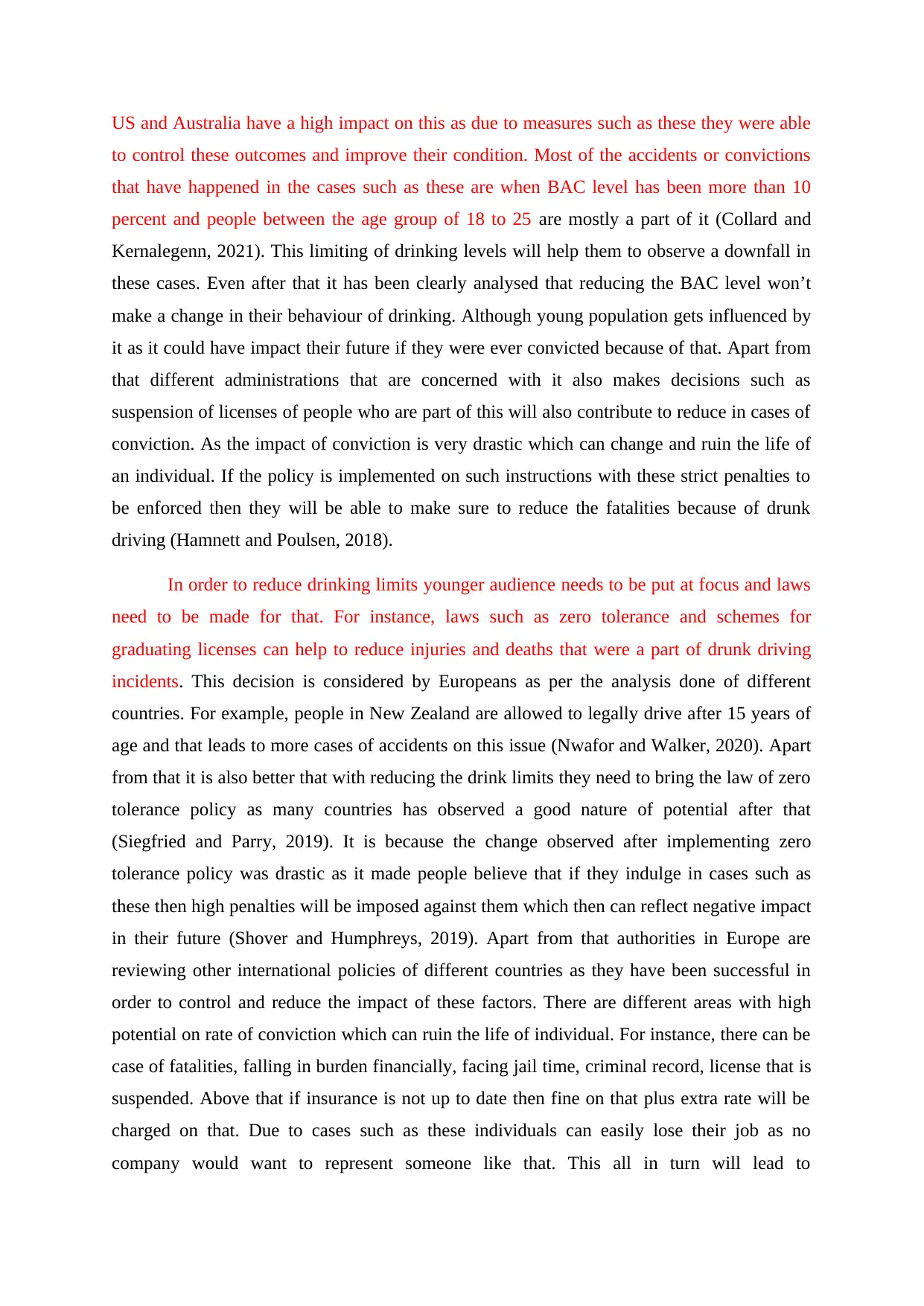
US and Australia have a high impact on this as due to measures such as these they were able
to control these outcomes and improve their condition. Most of the accidents or convictions
that have happened in the cases such as these are when BAC level has been more than 10
percent and people between the age group of 18 to 25 are mostly a part of it (Collard and
Kernalegenn, 2021). This limiting of drinking levels will help them to observe a downfall in
these cases. Even after that it has been clearly analysed that reducing the BAC level won’t
make a change in their behaviour of drinking. Although young population gets influenced by
it as it could have impact their future if they were ever convicted because of that. Apart from
that different administrations that are concerned with it also makes decisions such as
suspension of licenses of people who are part of this will also contribute to reduce in cases of
conviction. As the impact of conviction is very drastic which can change and ruin the life of
an individual. If the policy is implemented on such instructions with these strict penalties to
be enforced then they will be able to make sure to reduce the fatalities because of drunk
driving (Hamnett and Poulsen, 2018).
In order to reduce drinking limits younger audience needs to be put at focus and laws
need to be made for that. For instance, laws such as zero tolerance and schemes for
graduating licenses can help to reduce injuries and deaths that were a part of drunk driving
incidents. This decision is considered by Europeans as per the analysis done of different
countries. For example, people in New Zealand are allowed to legally drive after 15 years of
age and that leads to more cases of accidents on this issue (Nwafor and Walker, 2020). Apart
from that it is also better that with reducing the drink limits they need to bring the law of zero
tolerance policy as many countries has observed a good nature of potential after that
(Siegfried and Parry, 2019). It is because the change observed after implementing zero
tolerance policy was drastic as it made people believe that if they indulge in cases such as
these then high penalties will be imposed against them which then can reflect negative impact
in their future (Shover and Humphreys, 2019). Apart from that authorities in Europe are
reviewing other international policies of different countries as they have been successful in
order to control and reduce the impact of these factors. There are different areas with high
potential on rate of conviction which can ruin the life of individual. For instance, there can be
case of fatalities, falling in burden financially, facing jail time, criminal record, license that is
suspended. Above that if insurance is not up to date then fine on that plus extra rate will be
charged on that. Due to cases such as these individuals can easily lose their job as no
company would want to represent someone like that. This all in turn will lead to
to control these outcomes and improve their condition. Most of the accidents or convictions
that have happened in the cases such as these are when BAC level has been more than 10
percent and people between the age group of 18 to 25 are mostly a part of it (Collard and
Kernalegenn, 2021). This limiting of drinking levels will help them to observe a downfall in
these cases. Even after that it has been clearly analysed that reducing the BAC level won’t
make a change in their behaviour of drinking. Although young population gets influenced by
it as it could have impact their future if they were ever convicted because of that. Apart from
that different administrations that are concerned with it also makes decisions such as
suspension of licenses of people who are part of this will also contribute to reduce in cases of
conviction. As the impact of conviction is very drastic which can change and ruin the life of
an individual. If the policy is implemented on such instructions with these strict penalties to
be enforced then they will be able to make sure to reduce the fatalities because of drunk
driving (Hamnett and Poulsen, 2018).
In order to reduce drinking limits younger audience needs to be put at focus and laws
need to be made for that. For instance, laws such as zero tolerance and schemes for
graduating licenses can help to reduce injuries and deaths that were a part of drunk driving
incidents. This decision is considered by Europeans as per the analysis done of different
countries. For example, people in New Zealand are allowed to legally drive after 15 years of
age and that leads to more cases of accidents on this issue (Nwafor and Walker, 2020). Apart
from that it is also better that with reducing the drink limits they need to bring the law of zero
tolerance policy as many countries has observed a good nature of potential after that
(Siegfried and Parry, 2019). It is because the change observed after implementing zero
tolerance policy was drastic as it made people believe that if they indulge in cases such as
these then high penalties will be imposed against them which then can reflect negative impact
in their future (Shover and Humphreys, 2019). Apart from that authorities in Europe are
reviewing other international policies of different countries as they have been successful in
order to control and reduce the impact of these factors. There are different areas with high
potential on rate of conviction which can ruin the life of individual. For instance, there can be
case of fatalities, falling in burden financially, facing jail time, criminal record, license that is
suspended. Above that if insurance is not up to date then fine on that plus extra rate will be
charged on that. Due to cases such as these individuals can easily lose their job as no
company would want to represent someone like that. This all in turn will lead to
Paraphrase This Document
Need a fresh take? Get an instant paraphrase of this document with our AI Paraphraser
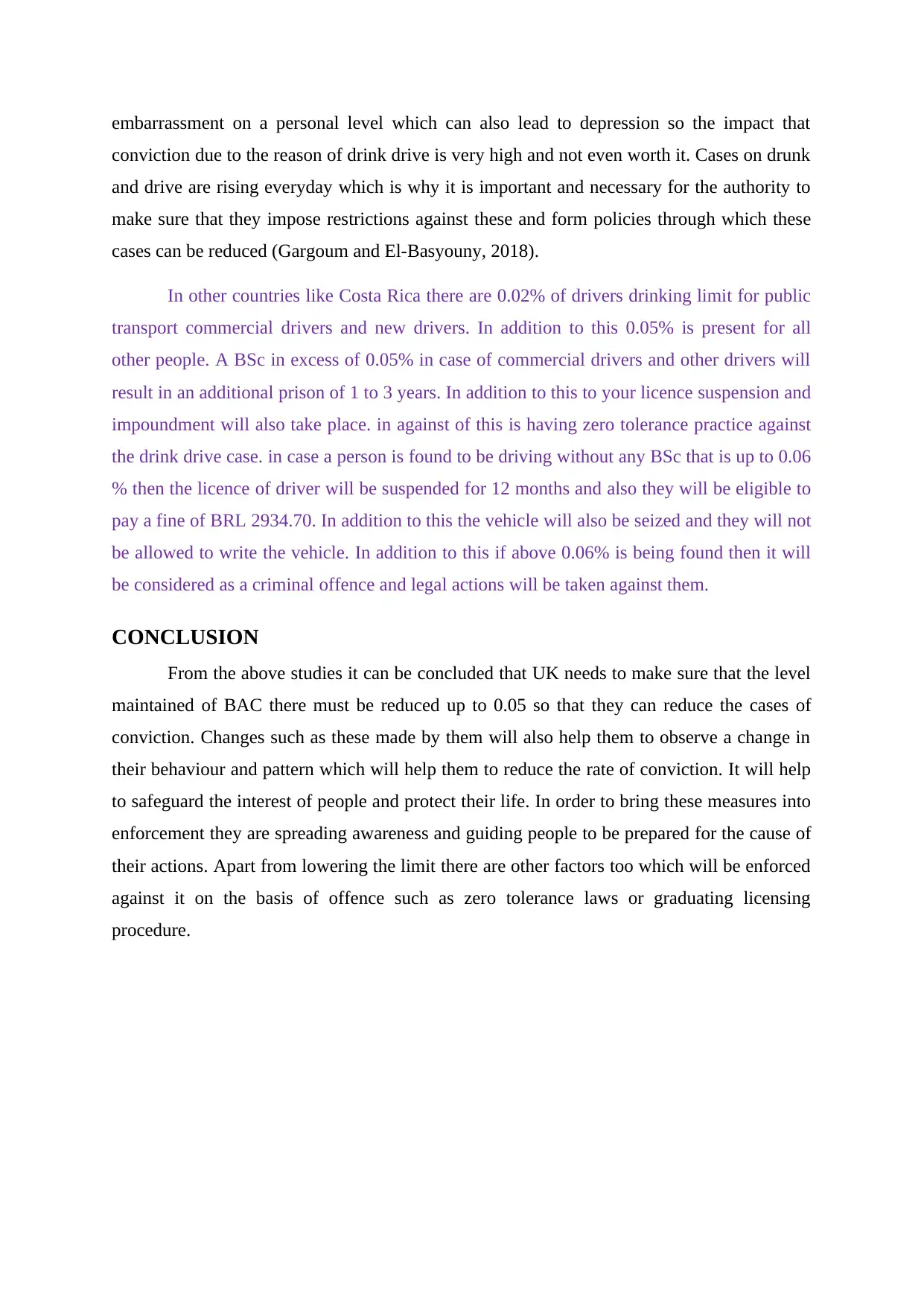
embarrassment on a personal level which can also lead to depression so the impact that
conviction due to the reason of drink drive is very high and not even worth it. Cases on drunk
and drive are rising everyday which is why it is important and necessary for the authority to
make sure that they impose restrictions against these and form policies through which these
cases can be reduced (Gargoum and El-Basyouny, 2018).
In other countries like Costa Rica there are 0.02% of drivers drinking limit for public
transport commercial drivers and new drivers. In addition to this 0.05% is present for all
other people. A BSc in excess of 0.05% in case of commercial drivers and other drivers will
result in an additional prison of 1 to 3 years. In addition to this to your licence suspension and
impoundment will also take place. in against of this is having zero tolerance practice against
the drink drive case. in case a person is found to be driving without any BSc that is up to 0.06
% then the licence of driver will be suspended for 12 months and also they will be eligible to
pay a fine of BRL 2934.70. In addition to this the vehicle will also be seized and they will not
be allowed to write the vehicle. In addition to this if above 0.06% is being found then it will
be considered as a criminal offence and legal actions will be taken against them.
CONCLUSION
From the above studies it can be concluded that UK needs to make sure that the level
maintained of BAC there must be reduced up to 0.05 so that they can reduce the cases of
conviction. Changes such as these made by them will also help them to observe a change in
their behaviour and pattern which will help them to reduce the rate of conviction. It will help
to safeguard the interest of people and protect their life. In order to bring these measures into
enforcement they are spreading awareness and guiding people to be prepared for the cause of
their actions. Apart from lowering the limit there are other factors too which will be enforced
against it on the basis of offence such as zero tolerance laws or graduating licensing
procedure.
conviction due to the reason of drink drive is very high and not even worth it. Cases on drunk
and drive are rising everyday which is why it is important and necessary for the authority to
make sure that they impose restrictions against these and form policies through which these
cases can be reduced (Gargoum and El-Basyouny, 2018).
In other countries like Costa Rica there are 0.02% of drivers drinking limit for public
transport commercial drivers and new drivers. In addition to this 0.05% is present for all
other people. A BSc in excess of 0.05% in case of commercial drivers and other drivers will
result in an additional prison of 1 to 3 years. In addition to this to your licence suspension and
impoundment will also take place. in against of this is having zero tolerance practice against
the drink drive case. in case a person is found to be driving without any BSc that is up to 0.06
% then the licence of driver will be suspended for 12 months and also they will be eligible to
pay a fine of BRL 2934.70. In addition to this the vehicle will also be seized and they will not
be allowed to write the vehicle. In addition to this if above 0.06% is being found then it will
be considered as a criminal offence and legal actions will be taken against them.
CONCLUSION
From the above studies it can be concluded that UK needs to make sure that the level
maintained of BAC there must be reduced up to 0.05 so that they can reduce the cases of
conviction. Changes such as these made by them will also help them to observe a change in
their behaviour and pattern which will help them to reduce the rate of conviction. It will help
to safeguard the interest of people and protect their life. In order to bring these measures into
enforcement they are spreading awareness and guiding people to be prepared for the cause of
their actions. Apart from lowering the limit there are other factors too which will be enforced
against it on the basis of offence such as zero tolerance laws or graduating licensing
procedure.
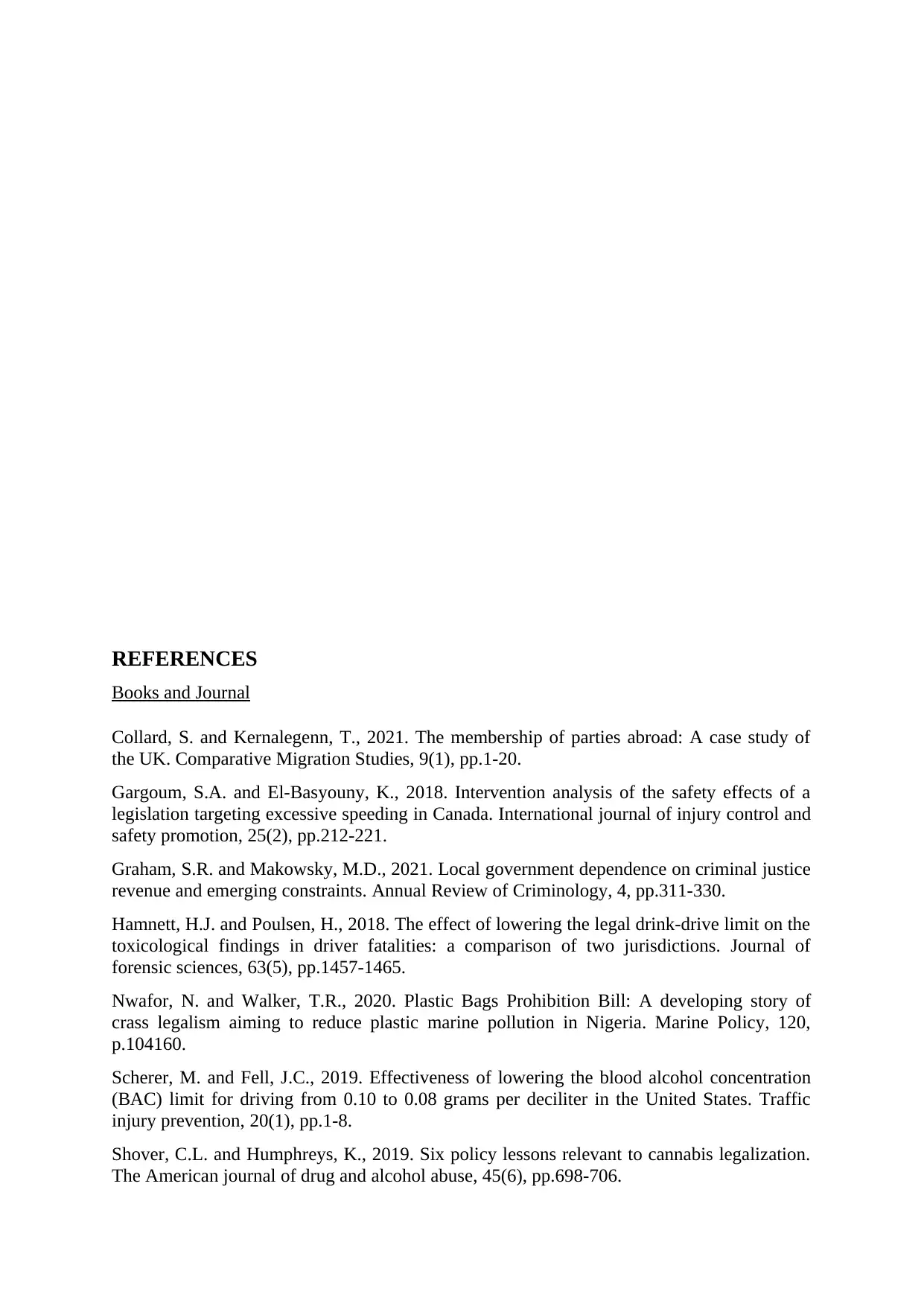
REFERENCES
Books and Journal
Collard, S. and Kernalegenn, T., 2021. The membership of parties abroad: A case study of
the UK. Comparative Migration Studies, 9(1), pp.1-20.
Gargoum, S.A. and El-Basyouny, K., 2018. Intervention analysis of the safety effects of a
legislation targeting excessive speeding in Canada. International journal of injury control and
safety promotion, 25(2), pp.212-221.
Graham, S.R. and Makowsky, M.D., 2021. Local government dependence on criminal justice
revenue and emerging constraints. Annual Review of Criminology, 4, pp.311-330.
Hamnett, H.J. and Poulsen, H., 2018. The effect of lowering the legal drink‐drive limit on the
toxicological findings in driver fatalities: a comparison of two jurisdictions. Journal of
forensic sciences, 63(5), pp.1457-1465.
Nwafor, N. and Walker, T.R., 2020. Plastic Bags Prohibition Bill: A developing story of
crass legalism aiming to reduce plastic marine pollution in Nigeria. Marine Policy, 120,
p.104160.
Scherer, M. and Fell, J.C., 2019. Effectiveness of lowering the blood alcohol concentration
(BAC) limit for driving from 0.10 to 0.08 grams per deciliter in the United States. Traffic
injury prevention, 20(1), pp.1-8.
Shover, C.L. and Humphreys, K., 2019. Six policy lessons relevant to cannabis legalization.
The American journal of drug and alcohol abuse, 45(6), pp.698-706.
Books and Journal
Collard, S. and Kernalegenn, T., 2021. The membership of parties abroad: A case study of
the UK. Comparative Migration Studies, 9(1), pp.1-20.
Gargoum, S.A. and El-Basyouny, K., 2018. Intervention analysis of the safety effects of a
legislation targeting excessive speeding in Canada. International journal of injury control and
safety promotion, 25(2), pp.212-221.
Graham, S.R. and Makowsky, M.D., 2021. Local government dependence on criminal justice
revenue and emerging constraints. Annual Review of Criminology, 4, pp.311-330.
Hamnett, H.J. and Poulsen, H., 2018. The effect of lowering the legal drink‐drive limit on the
toxicological findings in driver fatalities: a comparison of two jurisdictions. Journal of
forensic sciences, 63(5), pp.1457-1465.
Nwafor, N. and Walker, T.R., 2020. Plastic Bags Prohibition Bill: A developing story of
crass legalism aiming to reduce plastic marine pollution in Nigeria. Marine Policy, 120,
p.104160.
Scherer, M. and Fell, J.C., 2019. Effectiveness of lowering the blood alcohol concentration
(BAC) limit for driving from 0.10 to 0.08 grams per deciliter in the United States. Traffic
injury prevention, 20(1), pp.1-8.
Shover, C.L. and Humphreys, K., 2019. Six policy lessons relevant to cannabis legalization.
The American journal of drug and alcohol abuse, 45(6), pp.698-706.
⊘ This is a preview!⊘
Do you want full access?
Subscribe today to unlock all pages.

Trusted by 1+ million students worldwide
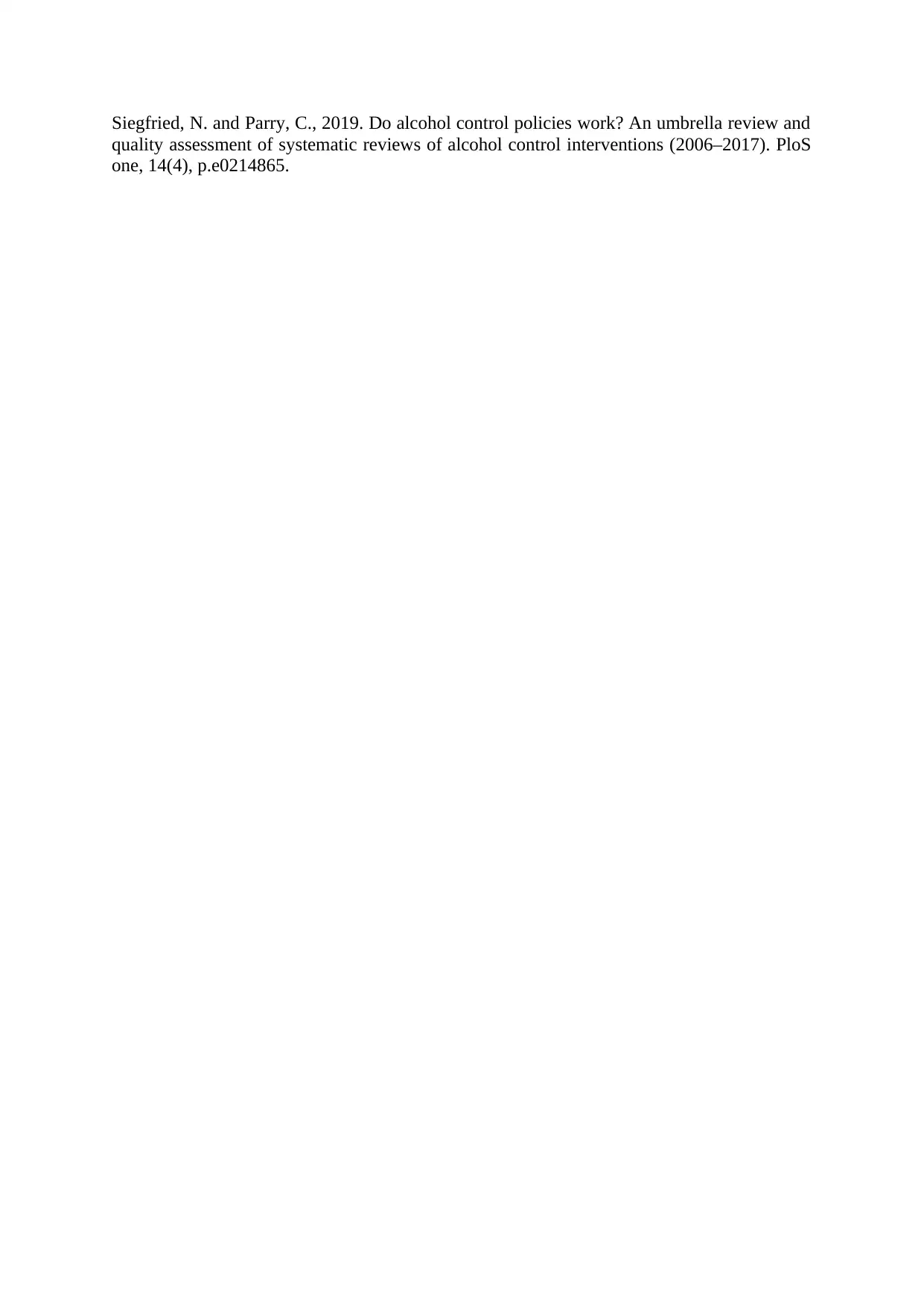
Siegfried, N. and Parry, C., 2019. Do alcohol control policies work? An umbrella review and
quality assessment of systematic reviews of alcohol control interventions (2006–2017). PloS
one, 14(4), p.e0214865.
quality assessment of systematic reviews of alcohol control interventions (2006–2017). PloS
one, 14(4), p.e0214865.
1 out of 7
Related Documents
Your All-in-One AI-Powered Toolkit for Academic Success.
+13062052269
info@desklib.com
Available 24*7 on WhatsApp / Email
![[object Object]](/_next/static/media/star-bottom.7253800d.svg)
Unlock your academic potential
Copyright © 2020–2025 A2Z Services. All Rights Reserved. Developed and managed by ZUCOL.




